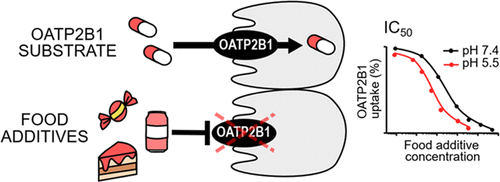当前位置:
X-MOL 学术
›
Mol. Pharmaceutics
›
论文详情
Our official English website, www.x-mol.net, welcomes your
feedback! (Note: you will need to create a separate account there.)
Food Additives as Inhibitors of Intestinal Drug Transporter OATP2B1.
Molecular Pharmaceutics ( IF 4.5 ) Pub Date : 2020-08-26 , DOI: 10.1021/acs.molpharmaceut.0c00507 Alli Tikkanen 1 , Estelle Pierrot 1 , Feng Deng 1, 2 , Virginia Barras Sánchez 1 , Marja Hagström 1 , Jan B Koenderink 3 , Heidi Kidron 1
Molecular Pharmaceutics ( IF 4.5 ) Pub Date : 2020-08-26 , DOI: 10.1021/acs.molpharmaceut.0c00507 Alli Tikkanen 1 , Estelle Pierrot 1 , Feng Deng 1, 2 , Virginia Barras Sánchez 1 , Marja Hagström 1 , Jan B Koenderink 3 , Heidi Kidron 1
Affiliation

|
Food additives are compounds that are added to food and beverage to improve the taste, color, preservation, or composition. Generally, food additives are considered safe for human use due to safety evaluations conducted by food safety authorities and high safety margins applied to permitted usage levels. However, the interaction potential of food additives with simultaneously administered medication has not received much attention. Even though many food additives are poorly absorbed into systemic circulation, high concentrations could exist in the intestinal lumen, making intestinal drug transporters, such as the uptake transporter organic anion transporting polypeptide 2B1 (OATP2B1), a possible site of food additive–drug interactions. In the present work, we aimed to characterize the interaction of a selection of 25 food additives including colorants, preservatives, and sweeteners with OATP2B1 in vitro. In human embryonic kidney 293 (HEK293) cells transiently overexpressing OATP2B1 or control, uptake of dibromofluorescein was studied with and without 50 μM food additive at pH 7.4. As OATP2B1 displays substrate- and pH-dependent transport functions and the intraluminal pH varies along the gastrointestinal tract, we performed the studies also at pH 5.5 using estrone sulfate as an OATP2B1 substrate. Food additives that inhibited OATP2B1-mediated substrate transport by ≥50% were subjected to dose–response studies. Six colorants were identified and validated as OATP2B1 inhibitors at pH 5.5, but only three of these were categorized as inhibitors at pH 7.4. One sweetener was validated as an inhibitor under both assay conditions, whereas none of the preservatives exhibited ≥50% inhibition of OATP2B1-mediated transport. Extrapolation of computed inhibitory constants (Ki values) to estimations of intestinal food additive concentrations implies that selected colorants could inhibit intestinal OATP2B1 also in vivo. These results suggest that food additives, especially colorants, could alter the pharmacokinetics of orally administered OATP2B1 substrate drugs, although further in vivo studies are warranted to understand the overall clinical consequences of the findings.
中文翻译:

作为肠道药物转运蛋白 OATP2B1 抑制剂的食品添加剂。
食品添加剂是添加到食品和饮料中以改善口味、颜色、保存或成分的化合物。一般来说,食品添加剂被认为对人类使用是安全的,因为食品安全当局进行了安全评估,并且适用于允许的使用水平的高安全裕度。然而,食品添加剂与同时给药的药物之间的相互作用潜力并未受到太多关注。尽管许多食品添加剂很难被全身循环吸收,但肠腔中可能存在高浓度,这使得肠道药物转运蛋白,如摄取转运蛋白有机阴离子转运多肽 2B1 (OATP2B1),可能是食品添加剂-药物相互作用的场所。在目前的工作中,体外. 在瞬时过表达 OATP2B1 或对照的人胚胎肾 293 (HEK293) 细胞中,研究了在 pH 7.4 下使用和不使用 50 μM 食品添加剂时二溴荧光素的摄取。由于 OATP2B1 显示底物和 pH 依赖性转运功能,并且腔内 pH 值沿胃肠道变化,我们还在 pH 5.5 下使用硫酸雌酮作为 OATP2B1 底物进行了研究。将 OATP2B1 介导的底物转运抑制 50% 以上的食品添加剂进行了剂量反应研究。六种着色剂被鉴定并验证为 pH 5.5 的 OATP2B1 抑制剂,但其中只有三种被归类为 pH 7.4 的抑制剂。一种甜味剂在两种测定条件下均被证实为抑制剂,而没有一种防腐剂对 OATP2B1 介导的转运具有≥50% 的抑制作用。K i值)对肠道食品添加剂浓度的估计意味着选定的着色剂也可以在体内抑制肠道 OATP2B1 。这些结果表明,食品添加剂,尤其是着色剂,可能会改变口服 OATP2B1 底物药物的药代动力学,尽管需要进一步的体内研究来了解这些发现的总体临床后果。
更新日期:2020-10-05
中文翻译:

作为肠道药物转运蛋白 OATP2B1 抑制剂的食品添加剂。
食品添加剂是添加到食品和饮料中以改善口味、颜色、保存或成分的化合物。一般来说,食品添加剂被认为对人类使用是安全的,因为食品安全当局进行了安全评估,并且适用于允许的使用水平的高安全裕度。然而,食品添加剂与同时给药的药物之间的相互作用潜力并未受到太多关注。尽管许多食品添加剂很难被全身循环吸收,但肠腔中可能存在高浓度,这使得肠道药物转运蛋白,如摄取转运蛋白有机阴离子转运多肽 2B1 (OATP2B1),可能是食品添加剂-药物相互作用的场所。在目前的工作中,体外. 在瞬时过表达 OATP2B1 或对照的人胚胎肾 293 (HEK293) 细胞中,研究了在 pH 7.4 下使用和不使用 50 μM 食品添加剂时二溴荧光素的摄取。由于 OATP2B1 显示底物和 pH 依赖性转运功能,并且腔内 pH 值沿胃肠道变化,我们还在 pH 5.5 下使用硫酸雌酮作为 OATP2B1 底物进行了研究。将 OATP2B1 介导的底物转运抑制 50% 以上的食品添加剂进行了剂量反应研究。六种着色剂被鉴定并验证为 pH 5.5 的 OATP2B1 抑制剂,但其中只有三种被归类为 pH 7.4 的抑制剂。一种甜味剂在两种测定条件下均被证实为抑制剂,而没有一种防腐剂对 OATP2B1 介导的转运具有≥50% 的抑制作用。K i值)对肠道食品添加剂浓度的估计意味着选定的着色剂也可以在体内抑制肠道 OATP2B1 。这些结果表明,食品添加剂,尤其是着色剂,可能会改变口服 OATP2B1 底物药物的药代动力学,尽管需要进一步的体内研究来了解这些发现的总体临床后果。











































 京公网安备 11010802027423号
京公网安备 11010802027423号